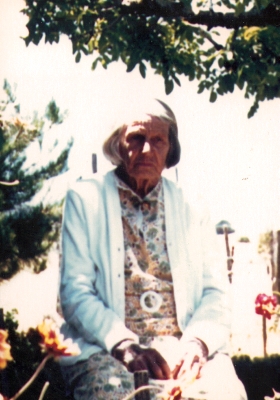Quilt No.80RB - Rosemary Blake
Owner:
Rosemary Blake
Location:
ACT
Maker
Maker:
Edith Perrott
Made in
AUSTRALIA NSW
Patterms
Date:
1941 - 1970
Description:
The inner part of the quilt is made from potato bags stitched together. These have been covered with a ticking type fabric held to the bags with large stitches using a string type thread. This whole inner layer is covered with muslin, dyed orange. The dye is thought to have been a Dolly dye. The quilt is very heavy. There are small hand stitches in each corner through all layers.
1770 x 1520 mm
1770 x 1520 mm
History:
The quilt was made by Mrs. Edith Perrott for her son Glen and his wife Peggy's marriage in 1943. Peggy later gave it to her daughter Rosemary, grand daughter of the maker. It is used occasionally.
Story:
Mrs. Edith Perrott, born Bartholomew, (1879 - 1970) of Tumbarumba NSW made this quilt for her son Glen and his wife Peggy when they were married in Tumbarumba in 1943. It is similar in construction to a smaller one made 2 years later.

Edith Perrott, 1968
Related Quilts:
Wholecloth pram quilt with a top of pink cotton sateen, and the reverse is a more finely woven, ivory, fabric. All over quilting design as main feature, with stylised hearts, leaves and cross hatching. The padding is cotton batting. 870 x 660 mm.
Hand stitched, cotton, appliquéd, quilt in a flower pattern on a plain background. Colours are shades of green, apricot and browns. This quilt was known as a 'Bride's Quilt'. Padding is thought to be layers of white fabric raised almost like a wadding. The backing is cotton material. 2470 x 2020 mm.
" Reversible patchwork quilt of woollen suiting/upholstery fabrics in khaki, greys, blues and browns. Both sides have different designs. The front of the quilt has 13 rows of 12 vertical rectangles flanked on either side by a column of 22 horizontal rectangles. The reverse has a more interesting and complex design of small and very large rectangles, squares and triangles; with khaki contrasting with the duller greys and blues. The patchwork layers are joined at the edges with machine stitching and the quilt is machine quilted along 3 horizontal lines following joins in the patchwork; therefore not being totally straight. These lines are more noticeable on the reverse. The reverse face has been on display at the NGA." [NGA] There is a cotton blanket used as padding. 2054 x 1451mm
Utilitarian quilt. Padding consists of recycled hand knitted jumper pieces (mainly 3 ply crepe and 8 ply) tacked to a layer of cotton material with strong buttonhole twist thread. The top is a piece of cotton fabric. Machine quilted in rows approximately 70mm apart.
1827 x 1423mm
1827 x 1423mm
Wholecloth quilt of fine cream homespun embroidered with red and white stranded cotton. It is a cross stitch design of roses pre stamped on the material. The quilting consists of a fern pattern medallion in the centre, straight lines and a fern pattern border. The padding is fine wadding and the backing is white sheeting with a small floral pattern,
2160 x 1650mm
2160 x 1650mm
Wholecloth quilt made from deep pink satin. The quilting pattern is a centre circle with a stylised flower surrounded by crescent shapes. This is set in a square and there is a fan design in each corner. Parallel lines create a border. There is a frill on all sides of the quilt. The padding is raw cotton.
2000 x 1770 mm
2000 x 1770 mm








